Best Workforce Management Software
Best workforce management software are Clockify, Workday, Paylocity, Keka HR, and BambooHR. Such workforce management tools help businesses manage staff scheduling and create the optimal flow for their organization.



No Cost Personal Advisor
List of 20 Best Workforce Management Software
Freelancer Management System
Transformify(TFY) workforce management system is trusted by businesses on 4 continents to streamline contractor management and fully automate onboarding,compliance, billing & payments to independent contractors,freelancers & employees. Learn more about Transformify
Explore various Transformify features, compare the pricing plans, and unlock the potential of seamless operations by selecting the right software for your business.
Features
View all Transformify Features- Online Invoice Payment
- Employer Accounts
- Calendar Management
- Employee Self Service Management
- Applicant tracking
- File Sharing
- Member Portal
- Scorecards
Pricing
Transformify Caters to
- StartUps
- SMBs
- Agencies
- Enterprises
Category Champions | 2024
Software by Papaya Global
Papaya Global is a fully functional workforce management system for SMEs, start-ups, and large businesses. This tool offers end-to-end solutions created for Web App and Android. This online WFM platform brings useful features like Cap Table Management, Document Storage, Compliance Management, Financial Modelling, Scheduling, Reporting/Analytics, Self Service Portal, Vacation/Leave Tracking and more in one location. Read Papaya Global Reviews
Explore various Papaya Global features, compare the pricing plans, and unlock the potential of seamless operations by selecting the right software for your business.
Features
View all Papaya Global Features- Payroll Management
- Dashboard
- Direct Deposit
- Employee Onboarding and Offboarding
- Workforce Management
- Compliance Management
- Employee Portal
- Benefits Management
Pricing
Papaya Global Caters to
- StartUps
- SMBs
- Agencies
- Enterprises
Category Champions | 2024
Cloud workforce management software
factoHR is an award-winning Best HR Platform trusted by 3500 Companies & 2.6 million employees, which includes Tata Steel BSL, DENSO, Cycle Agarbatti, BSE, Murugappa, & many others who have improved their productivity by more than 70 % Read factoHR Reviews
Explore various factoHR features, compare the pricing plans, and unlock the potential of seamless operations by selecting the right software for your business.
Features
View all factoHR Features- Exit Management
- Employee Database
- Multi Level Approval Workflows
- Payroll Integration
- Batch Processing
- Employee Self Service Management
- On-Boarding
- Attendance Tracking
factoHR Caters to
- StartUps
- SMBs
- Agencies
- Enterprises
Category Champions | 2024
Commitment delivered
Wallet HR is a unified, user-friendly solution that assists companies of all sizes in automating routine HR procedures. This Workforce Management platform provides comprehensive HR solutions covering every stage of an employee's career, from hiring to retirement. The customer may receive this solution as a product to use at his place of business. Read Wallet HR Reviews
Explore various Wallet HR features, compare the pricing plans, and unlock the potential of seamless operations by selecting the right software for your business.
Features
View all Wallet HR Features- Fixed Asset Management
- Geo tracking
- Employee Database
- Employment Screening
- Employee Management
- Interview Scheduling
- Budgeting & Forecasting
- Digital Offer Letters
Wallet HR Caters to
- StartUps
- SMBs
- Agencies
- Enterprises
Emergents | 2024
A complete HR solution that improves end to end em
Oracle Fusion Cloud HCM is an exhaustive cloud solution that consolidates all of your company's human resource operations. By providing a complete solution to manage every stage of the employee lifecycle, from recruiting, screening, and hiring, to onboarding, managing time and absence, and more, this Workforce Management Software helps HR leaders to reduce their workload. Learn more about Oracle Fusion Cloud HCM
Explore various Oracle Fusion Cloud HCM features, compare the pricing plans, and unlock the potential of seamless operations by selecting the right software for your business.
- Talent Management
- Payroll Management
- Workforce Management
- Employee Lifecycle Management
- Learning Management
- Internal HR
- Reporting/Analytics
- Employee Management
Oracle Fusion Cloud HCM Caters to
- StartUps
- SMBs
- Agencies
- Enterprises
Category Champions | 2024
Complete employee experience platform
Keka is a cloud-based Workforce Management Solution that aids companies in managing employee profiles, monitoring attendance, processing hiring, and evaluating performance. Keka provides you with an up-close perspective of the real-time location status of every employee on a single dashboard. Some convenient features are GPS, pulse surveys, role-based permissions, document storage, workflow management, helpdesk, and asset monitoring. Read Keka Reviews
Explore various Keka features, compare the pricing plans, and unlock the potential of seamless operations by selecting the right software for your business.
Features
View all Keka Features- Exit Management & Seperation Management
- Employee Data Base
- Employee Directory
- Feedback Management
- Goals
- Payroll Integration
- Custom Rating Scales
- Project Management
Pricing
Foundation
$ 97
Upto 100 Employees
Strength
$ 194
Upto 100 Employees
Keka Caters to
- StartUps
- SMBs
- Agencies
- Enterprises
Category Champions | 2024
World's Most Powerful HR and Payroll Software
HRMantra is the World's most feature rich HR and Payroll software helping automate the most complicated of hire to retire HR processes easily using its CRORES of ready to use features. It saves 30 min per emp per day giving over 10 times ROI. 100% project success assured. Read HRMantra Reviews
Explore various HRMantra features, compare the pricing plans, and unlock the potential of seamless operations by selecting the right software for your business.
Features
View all HRMantra Features- Aptitude Testing
- Email Management
- Vacation / Leave Tracking
- MIS Reports
- Exit Management & Seperation Management
- Multi-Currency
- Multiuser Login & Role-based access control
- Employee Management
HRMantra Caters to
- StartUps
- SMBs
- Agencies
- Enterprises
Contenders | 2024
Global Payroll and Compliance
Deel is a Workforce Management System with the help of which users can build remote teams. This tool makes it easy to hire remote workers globally. The tool will take care of your global payroll, HR, and compliance so you can concentrate on international growth. Everything will be displayed on one robust dashboard that is simple to use. Read Deel Reviews
Explore various Deel features, compare the pricing plans, and unlock the potential of seamless operations by selecting the right software for your business.
Features
View all Deel Features- Contractor Management
- Background Screening
- Compliance Reporting
- Contract Management
- Time & Attendance Management
- Payroll Management
- Contact Management
- Performance Appraisal
Pricing
Deel HR
$ 0
Per Month
Contractors
$ 49
Per Month
EOR
$ 599
Per Month
Deel Caters to
- StartUps
- SMBs
- Agencies
- Enterprises
Emergents | 2024
Payroll Software on Cloud
ADP Vista is one of the best business workforce management tools for businesses. It is a highly customizable and secure HR software in the cloud. ADP Vista provides hassle-free, extremely secure end-to-end payroll software to businesses of all sizes and sectors. It delivers accurate employee pay calculation, streamlines payroll procedures, and conforms with local statutory authorities' laws and regulations. Read ADP Vista HCM Reviews
Explore various ADP Vista HCM features, compare the pricing plans, and unlock the potential of seamless operations by selecting the right software for your business.
Features
View all ADP Vista HCM Features- PF/ESIS Calculation
- Performance Management
- Attendance management
- Pay Slip
- Recruitment Management
- On-Boarding
- Self Service Portal
- Statutory Compliances
ADP Vista HCM Caters to
- StartUps
- SMBs
- Agencies
- Enterprises
Contenders | 2024
Software by Pioneer Works, Inc
Homebase is a Workforce Management Platform that makes managing payroll as easy as possible. It facilitates greater team communication, real-time labor cost tracking, and better task scheduling for the team. Any device can function as a time clock and scheduling app thanks to this employee time monitoring software. Employers can manage activities related to human resources, track hours spent, and set up timetables. Read Homebase Reviews
Explore various Homebase features, compare the pricing plans, and unlock the potential of seamless operations by selecting the right software for your business.
Features
View all Homebase Features- Resource cost estimation
- Events & Reminders
- HR & Payroll
- Shift Management
- Employee Database
- Mobile App Access
- Email Integration
- Dashboard
Pricing
Basic
$ 0
Per Month
Essentials
$ 25
Location/Month
Plus
$ 60
Location/Month
Homebase Caters to
- StartUps
- SMBs
- Agencies
- Enterprises
Emergents | 2024
Software by SyncHR
SyncHR is one of the best WFM software. It fits medium-sized businesses just right. It is a modern, cloud-based HR, payroll, and benefits platform created for rapidly expanding businesses needing more from their HCM solution. The tool offers useful features comprising a user-centric environment, smart tax setting, and non-linear payroll. Learn more about SyncHR
Explore various SyncHR features, compare the pricing plans, and unlock the potential of seamless operations by selecting the right software for your business.
Features
View all SyncHR Features- Performance Appraisal
- Resume Database
- Leave Management
- Workflow Management
- Pay Slip
- Appraisal Management
- Events & Reminders
- Time & Attendance Management
SyncHR Caters to
- StartUps
- SMBs
- Agencies
- Enterprises
Emergents | 2024
Software by Paylocity
Paylocity is a web-based solution for Talent management. This enterprise Workforce Management software offers all HR, Payroll, Benefits, and Time Management functions for businesses of any size and industry. Increasing the potential of your employees is simple with the aid of this all-encompassing talent management software. Learn more about Paylocity
Explore various Paylocity features, compare the pricing plans, and unlock the potential of seamless operations by selecting the right software for your business.
Features
View all Paylocity Features- Training Management
- Onboarding
- Compensation Management
- Employee Lifecycle Management
- Job Description Management
- Succession Planning
- Goal Setting / Tracking
- Performance Appraisal
Paylocity Caters to
- StartUps
- SMBs
- Agencies
- Enterprises
Contenders | 2024
One Platform To Manage All Your Field Operations
Effort is a Field Force and Workforce management tool. The program conforms to time- and place-sensitive activities. All firms can customize and adapt Effort to their needs. It is a DIY platform with no coding required. Among other capabilities, a few include service history tracking, scheduling, dispatch management, and field sales management. Read EFFORT Reviews
Explore various EFFORT features, compare the pricing plans, and unlock the potential of seamless operations by selecting the right software for your business.
Features
View all EFFORT Features- Service History Tracking
- Push Notifications
- Punch card
- Chat / Messaging
- Vacation/Leave Tracking
- Barcode Scanning
- QR Codes
- Map Creation
Pricing
Starter
$ 8
Per User
EFFORT Caters to
- StartUps
- SMBs
- Agencies
- Enterprises
Contenders | 2024
The new standard in global HR
Remote is one of the best workforce management software companies that allows businesses to manage and pay full-time and contract employees anywhere in the world. The tool handles foreign payroll, benefits, taxes, stock options, and compliance in over 50 nations. Most significantly, Remote charges a low flat rate so that you can keep your spending in check and concentrate on growing your business. Read Remote Reviews
Explore various Remote features, compare the pricing plans, and unlock the potential of seamless operations by selecting the right software for your business.
Features
View all Remote Features- Contractor Management
- Multi-State
- Salary Information & History
- Contract Management
- For Employers
- Tax Management
- Multi-Country
- Time Off Management
Pricing
Employer of Record Services
$ 299
Employee/Month
Contractor Management Services
$ 0
Contractor/Month
Remote Caters to
- StartUps
- SMBs
- Agencies
- Enterprises
Contenders | 2024
Integrated Payroll Management Solution
UZIO provides cloud-based HR, benefits, and payroll management software. By assisting companies in going digital in all facets of their everyday operations, this is one of the best workforce tracking software that assists HR teams in managing expenses and improving the employee experience. Your HR and benefits data are effortlessly integrated with UZIO's cloud-based payroll technology. Read UZIO Payroll Reviews
Explore various UZIO Payroll features, compare the pricing plans, and unlock the potential of seamless operations by selecting the right software for your business.
Features
View all UZIO Payroll Features- User Onboarding
- Multiple Billing Rates
- Workforce Management
- Salary Adjustment
- Time & Attendance
- Activity / News Feed
- FSA Administration
- FMLA Administration
Pricing
Full Service Payroll
$ 5
Per Employee/Month
UZIO Payroll Caters to
- StartUps
- SMBs
- Agencies
- Enterprises
Contenders | 2024
Software by Sap
SAP SuccessFactors is an online-based WFM software. Its WFM tools are best suited for small businesses. The core functions are payroll management, applicant tracking, performance reviews, onboarding, learning, goal, and compensation management. This solution facilitates the standardization of HR procedures and offers transparency for better personnel decisions. Read SAP SuccessFactors Reviews
Explore various SAP SuccessFactors features, compare the pricing plans, and unlock the potential of seamless operations by selecting the right software for your business.
Features
View all SAP SuccessFactors Features- Talent Management
- On-Boarding
- Leave Management
- HR & Payroll
- Career Development Planning
- Training Management
- Self-onboarding
- Applicant tracking
SAP SuccessFactors Caters to
- StartUps
- SMBs
- Agencies
- Enterprises
Contenders | 2024
Software by Rippling
Rippling is a fully functional Workforce Management Solution created for agencies and businesses. Rippling offers comprehensive Macintosh solutions. Multi-Country, E-Verify/I-9 Forms, Employee Database, Recruitment Management, and Employee Lifecycle Management are a few features provided by this online HR solution in one location. Read Rippling Reviews
Explore various Rippling features, compare the pricing plans, and unlock the potential of seamless operations by selecting the right software for your business.
Features
View all Rippling Features- Applicant tracking
- Check Printing
- Electronic Signature
- Employee Lifecycle Management
- Electronic Forms
- Inventory Management
- Policy Management
- Onboarding and offboarding
Rippling Caters to
- StartUps
- SMBs
- Agencies
- Enterprises
Contenders | 2024
The all-in-one app for managing deskless employees
One of the top workforce management software, Connecteam, can help managers automate business processes, focus on business growth, and free up staff people to be more productive, flexible, and content. Connecteam provides a centralized, all-in-one platform where you can share files with your team, plan work, assign tasks, and remain informed about corporate news and announcements. Read Connecteam Reviews
Explore various Connecteam features, compare the pricing plans, and unlock the potential of seamless operations by selecting the right software for your business.
Features
View all Connecteam Features- Attendee Management
- Dock Management
- Attendance Tracking
- Surveys & Feedback
- Team Management
- Reminders
- Employee scheduling
- Activity Dashboard
Pricing
Small Business - Free
$ 0
10 Users
Basic
$ 29
30 Users Per Month
Advanced
$ 49
30 Users Per Month
Connecteam Caters to
- StartUps
- SMBs
- Agencies
- Enterprises
Category Champions | 2024
Software by BambooHR
BambooHR is one of the best workforce management software through which you can manage benefits enrollment; track hours worked, and process payroll, all from a single platform. Many HR services, including an application tracking system (ATS), time tracking, payroll processing, employee engagement, and employee satisfaction tools, are bundled into this human resources information system (HRIS). Read BambooHR Reviews
Explore various BambooHR features, compare the pricing plans, and unlock the potential of seamless operations by selecting the right software for your business.
Features
View all BambooHR Features- On-Boarding
- W-2/1099 Preparation
- Benefits Management
- Orientation Management
- Applicant tracking
- Employee Lifecycle Management
- For Employers
- Electronic Forms
BambooHR Caters to
- StartUps
- SMBs
- Agencies
- Enterprises
Emergents | 2024
Intelligence at work
Pay and time are combined into a single application in this Workforce Management Tool from the Workforce Management Software Company, Dayforce. As a result, any changes made to salary, working hours, and HR records are reflected in real time as it continuously calculates your data. Additionally, it implies that you can audit and validate data at any point during the pay cycle for more accurate, efficient payroll. Read Ceridian Dayforce Reviews
Explore various Ceridian Dayforce features, compare the pricing plans, and unlock the potential of seamless operations by selecting the right software for your business.
Features
View all Ceridian Dayforce Features- Succession Planning
- Timesheet Management
- Scheduling
- Employee Data Base
- Analytics
- Time Off Management
- Compliance Management
- Document Creation & Storage
Ceridian Dayforce Caters to
- StartUps
- SMBs
- Agencies
- Enterprises
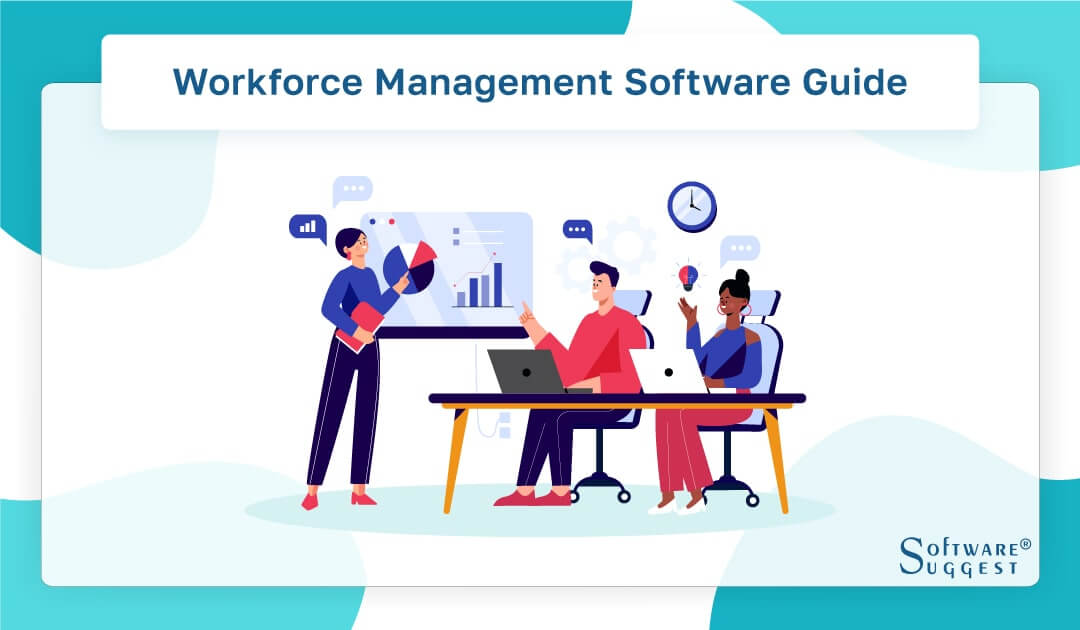
In today's fast-paced and evolving business landscape, organizations face numerous challenges in managing their workforce efficiently. From scheduling shifts and tracking attendance to optimizing employee productivity and ensuring compliance, workforce management is pivotal in driving operational success.
Fortunately, workforce management solutions have revolutionized how businesses approach these critical tasks. This guide provides a detailed overview of workforce management software, its features, benefits, and implementation considerations. Whether you're an HR professional seeking to streamline workforce processes or a business owner looking to enhance productivity, this guide will equip you with the knowledge needed to make informed decisions.
What is Workforce Management Software?
Workforce management software is a type of software program bundle that consists of mobile and desktop solutions to help businesses manage their staff scheduling procedures. Enterprises and businesses with a large workforce readily utilize the best workforce management solutions for managing shifts, schedules, workflows, and payrolls.
The primary objective of using workforce optimization software is to achieve transparency in business metrics, like the time taken by a task to complete or the amount of workforce required to complete a project.
Workforce management tools are designed to maximize employee productivity by ensuring they are in the right place at the right time. In addition, it helps a business manage staff scheduling.
Some standard functionality offered by the workforce management platform include:
- Labor scheduling
- Leave management
- Time and attendance
- Task and activity management
- Time and work data collection
More details regarding the features and benefits of mobile workforce management tools are discussed below.
Types of Workforce Management Software
A workforce management system provides businesses with efficient tools to manage various aspects of their workforce, from time and attendance tracking to performance management and talent development. Let's explore the different types of workforce management tools:
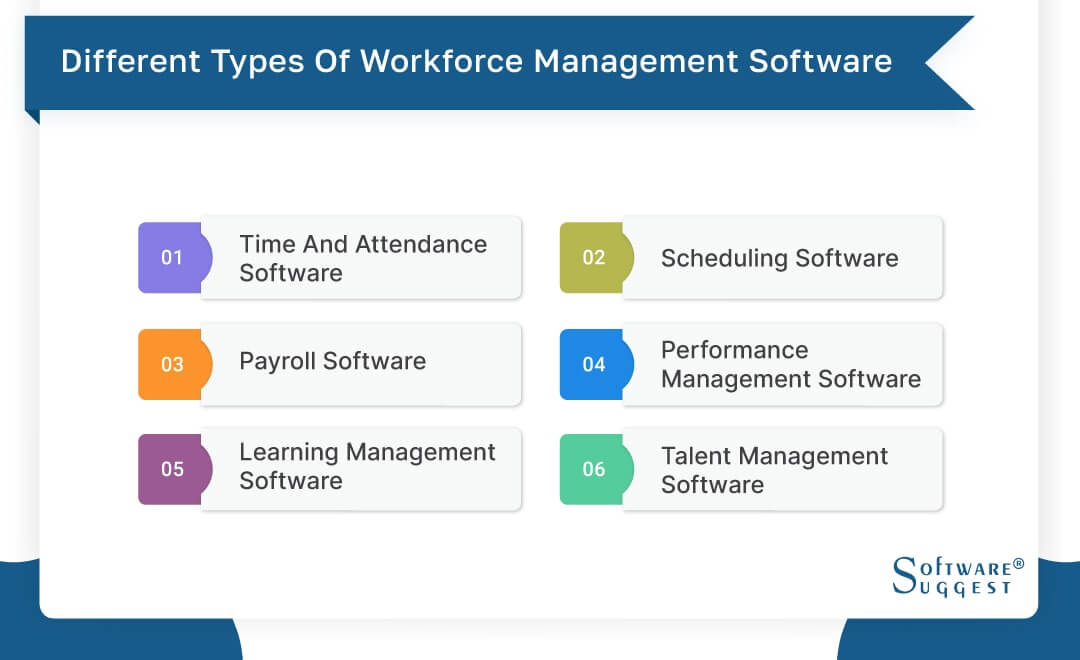
-
Time and Attendance Software
Time and attendance software enables businesses to accurately track and manage employee work hours, breaks, and time-off requests. These tools automate the process of time tracking, eliminate manual errors, and provide insights into employee attendance patterns. They often include features such as clock-in/clock-out functionality, time-off management, and reporting capabilities
-
Scheduling Software
Scheduling software helps businesses create, manage, and optimize employee schedules. These tools simplify the process of assigning shifts, managing shift swaps, and ensuring adequate coverage. Scheduling software often includes features like drag-and-drop scheduling, shift templates, and employee availability management, allowing businesses to allocate resources efficiently and minimize scheduling conflicts.
-
Payroll Software
Payroll software facilitates the accurate and timely calculation and distribution of employee wages. These tools automate payroll processes, including tax calculations, deductions, and direct deposit. Payroll software helps ensure compliance with labor laws and provides features for generating pay stubs, managing payroll taxes, and generating reports for financial purposes
-
Performance Management Software
Performance management software assists businesses in setting goals, conducting performance evaluations, and providing employee feedback. These tools enable managers to track employee performance, align individual goals with organizational objectives, and support employee development. Performance management software often includes goal setting, performance reviews, competency assessments, and feedback mechanisms
-
Learning Management Software
Learning management software facilitates the creation, delivery, and management of employee training and development programs. These tools provide a centralized platform for organizing and tracking training materials, e-learning modules, certifications, and assessments. Learning management software typically includes features like course creation, content management, progress tracking, and reporting
-
Talent Management Software
Talent management software focuses on attracting, developing, and retaining top talent within organizations. These tools encompass various HR processes, such as recruitment, onboarding, succession planning, and career development. Talent management software provides features like applicant tracking, performance reviews, employee profiles, and talent analytics to support strategic workforce planning and talent optimization
Who Uses Workforce Management Tools?
Workforce management tools have become an essential part of modern businesses, enabling organizations to manage their workforce and optimize operational processes efficiently. These tools cater to a wide range of industries and businesses of various sizes. Below are the different types of businesses and industries that benefit from using workforce management tools:
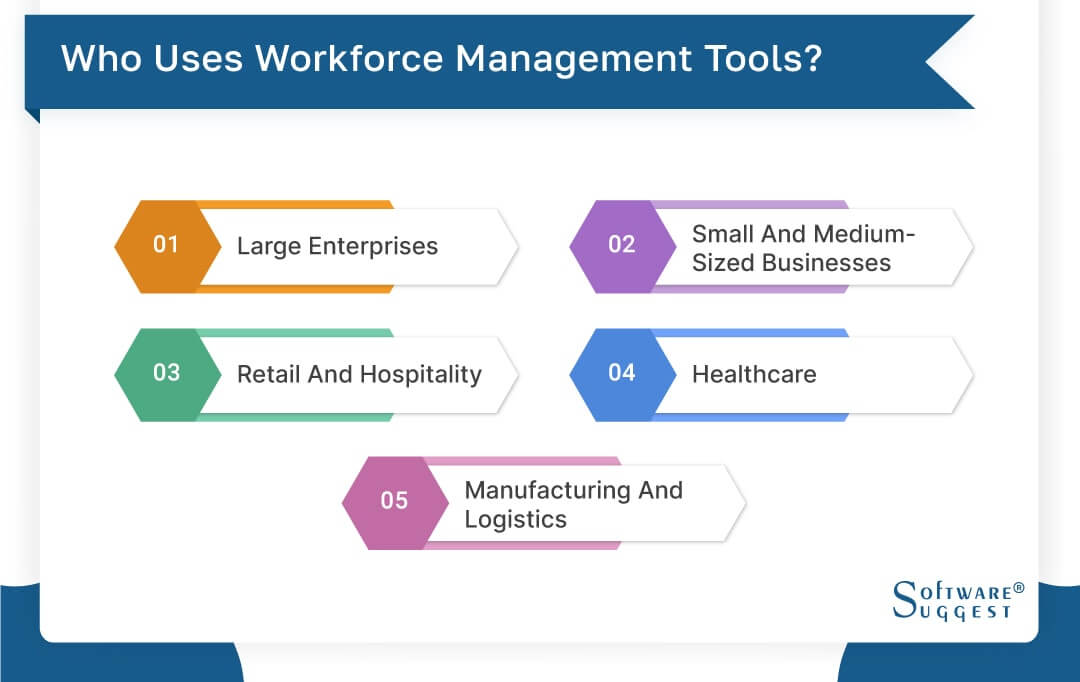
-
Large Enterprises
Large enterprises with extensive workforces often rely on workforce management tools to streamline their HR operations and maximize productivity. These tools help in managing complex scheduling needs, tracking attendance, automating payroll processes, and facilitating performance management on a large scale. Large enterprises benefit from the scalability and robust features offered by workforce management tools to manage their vast employee base effectively
-
Small and Medium-sized Businesses (SMBs)
Workforce management tools are equally valuable for small and medium-sized businesses (SMBs) as they enable them to automate and optimize their HR processes. SMBs may have limited resources and personnel, making it crucial to leverage technology for efficient workforce management. These tools assist SMBs in areas such as time and attendance tracking, scheduling, payroll management, and performance evaluations, enabling them to streamline operations and allocate resources effectively
-
Retail and Hospitality
The retail and hospitality industries have unique workforce management requirements due to their dynamic and customer-centric nature. Workforce management software plays a vital role in managing shift-based schedules, handling high volumes of part-time and seasonal employees, and ensuring seamless coordination among staff members. These tools help retail and hospitality businesses optimize staff allocation, manage employee availability, and improve customer service levels.
-
Healthcare
The healthcare industry heavily relies on workforce management tools to manage complex scheduling needs and ensure adequate staffing levels across various departments and shifts. These tools assist in managing employee certifications, tracking time and attendance, and ensuring compliance with labor regulations and healthcare standards. Workforce management tools in healthcare help optimize staff utilization, minimize scheduling gaps, and maintain high-quality patient care.
-
Manufacturing and Logistics
Manufacturing and logistics industries require precise workforce management to ensure smooth operations and meet production and delivery demands. Workforce management software helps schedule workers for different shifts, track time and attendance in manufacturing facilities, manage employee certifications and training, and optimize labor costs. These tools enhance efficiency, minimize production downtime, and improve overall operational productivity.
Benefits of Workforce Management System
If you are a business owner, no tool can help you maximize your workforce performance & management other than the top workforce management solutions. In many companies, the workforce is a significant expense, which includes salaries, benefits, training, and employee-related administration.
In addition, tracking all these expenses and managing them efficiently is a hassle, which costs organizations both time and money. If you are suffering from a similar predicament, workforce optimization software would be an excellent investment for your business.
Some of the top reasons to invest in enterprise workforce management software include:
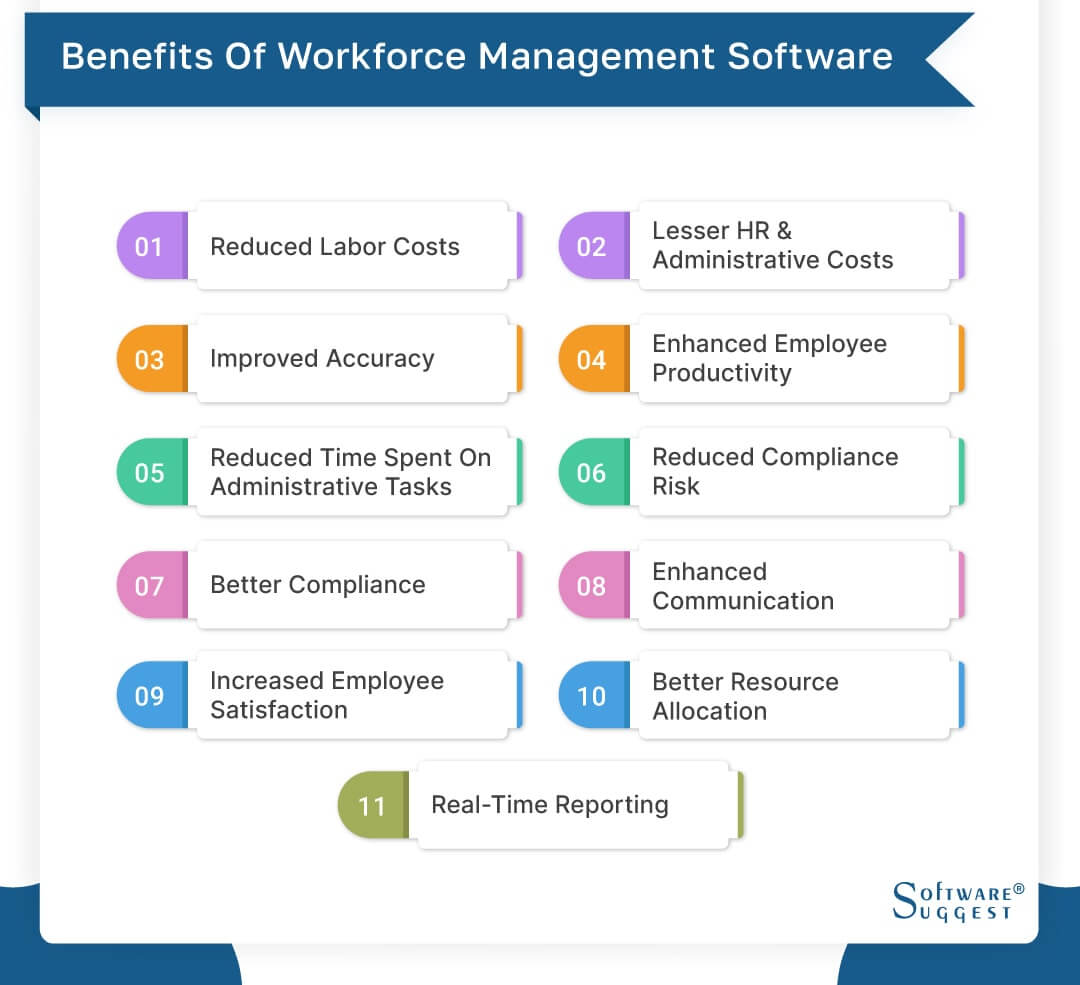
-
Reduced Labor Costs
Traditional attendance practices include punching, which had significant disadvantages as it had loopholes like employee buddy punching, paid late arrivals, extended breaks, and early departures.
Not only did manual attendance management cost time and money, but it also affected the overall operation of the organization as well. WFM tools, on the other hand, is entirely automated, which eliminates the need for manual attendance practices and offers accurate shift management and attendance as well
-
Lesser HR & Administrative Costs
Managing employee payrolls is a time-consuming process that requires high levels of administration. Using the best workforce management software, you can combine payroll, attendance, time, and other HR software, making it easy for you and your HR team to cut down the time & cost required for manual payroll management, along with reducing the chances of mistakes.
-
Improved Accuracy
Workforce management software reduces the risk of human error and improves accuracy in various HR processes such as time and attendance tracking, payroll calculations, and data management. Automation and standardized workflows minimize manual data entry and ensure precise calculations, leading to more accurate records and eliminating discrepancies.
-
Enhanced Employee Productivity
Workforce optimization software provides tools to manage time and workload efficiently, which increases the convenience of both employers and employees. For employers, a workforce management platform helps reduce absences, late arrivals, and early departures.
Employees, on the other hand, can have excellent transparency over their schedules and leaves and ensure they are getting paid at a time without any fraudulent leave penalties.
-
Reduced Time Spent On Administrative Tasks
Creating employee schedules, managing leaves, identifying and reporting absentees, and tracking late arrivals & early departures -- all of these tasks consume time and resources. Mobile labor management software can help automate all these tasks, making it easy for business owners and HR teams to use their time and resources efficiently.
-
Reduced Compliance Risk
Different countries have laws protecting employee rights to make sure they are getting appropriately paid for the hours of work they are doing. Recording employee hours and managing break & meal periods is also essential.
Recording this data manually is not only time-consuming but is prone to mistakes as well. Inaccurate employee information can increase the risk of non-compliance, a major threat to your organization.
Workforce optimization software can be of significant help in such situations by tracking employee data accurately to ensure your risk of non-compliance is eliminated.
-
Better Compliance
Workforce management software helps organizations maintain compliance with labor regulations, industry standards, and internal policies. The software for workforce management automates compliance-related tasks such as tracking hours worked, managing employee certifications, and generating reports for regulatory requirements. This ensures that organizations adhere to legal and ethical standards, minimizing compliance risks.
-
Enhanced Communication
WFM software facilitates seamless communication between managers, HR teams, and employees. It provides a centralized platform for sharing information, updates, and notifications regarding schedules, shifts, time-off requests, and policy changes. Improved communication leads to better coordination, reduced misunderstandings, and enhanced collaboration among team members.
-
Increased Employee Satisfaction
Efficient workforce management software contributes to increased employee satisfaction. Employees benefit from features such as self-service portals, where they can access their schedules, request time off, view pay stubs, and update personal information with workforce management scheduling software.
The software enables transparency, gives employees more control over their work-life balance, and improves overall engagement and satisfaction.
-
Better Resource Allocation
The top WFM software provides insights into employee availability, skills, and workload data, allowing managers to make informed decisions when allocating resources. The software helps optimize staffing levels, ensures adequate coverage during busy periods, and minimizes understaffing or overstaffing situations. This leads to better resource utilization and cost optimization.
-
Real-time Reporting
Workforce management software generates real-time reports and analytics on various HR metrics such as attendance, productivity, labor costs, and employee performance. These reports provide valuable insights into workforce trends, enable data-driven decision-making, and support strategic planning. Real-time reporting helps organizations identify areas for improvement, measure KPIs, and track progress toward goals.
Features of Best Workforce Management Software
The best WFM software offers comprehensive features designed to streamline HR processes, optimize workforce planning, and enhance overall productivity within organizations. These software solutions provide a range of functionalities that enable efficient management of various aspects of the workforce.
Let's explore the key features of the best workforce management software.
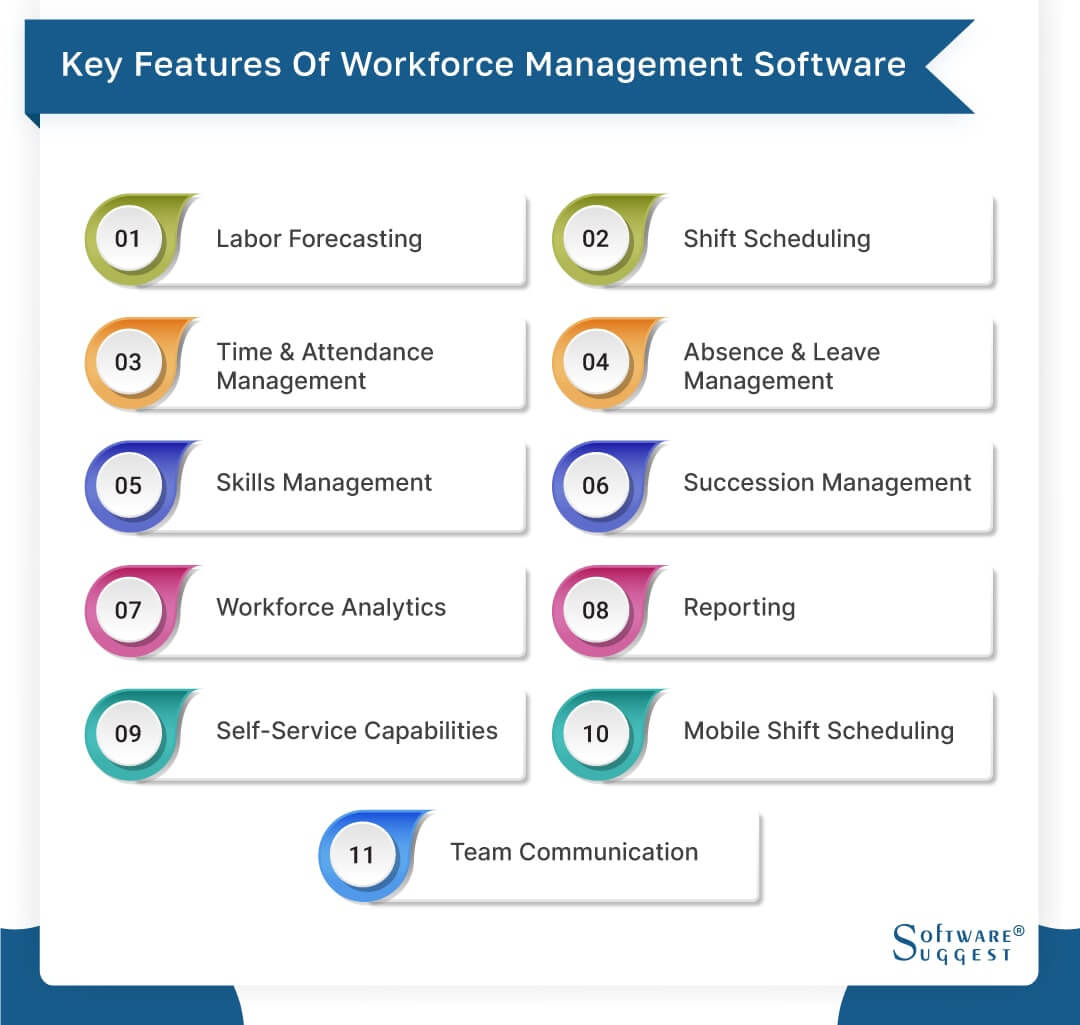
-
Labor Forecasting
Labor forecasting features in workforce management software help organizations predict and plan their workforce needs based on historical data, trends, and future demand. This feature assists in optimizing staffing levels, aligning resources with workload demands, and ensuring adequate coverage during peak periods while avoiding unnecessary labor costs during slower periods.
-
Shift Scheduling
Shift scheduling functionality enables businesses to create and manage employee schedules efficiently. A workforce management system offers intuitive tools to allocate shifts, assign tasks, and handle scheduling conflicts. These features automate the process, consider employee availability, skills, and preferences, and help optimize the schedule for better productivity and employee satisfaction.
-
Time & Attendance Management
Time and attendance management features automate the tracking of employee work hours, breaks, and attendance. Workforce management software simplifies the process, replacing manual time cards with digital solutions such as clock-in/clock-out functionalities, biometric systems, or mobile apps. This feature helps ensure accurate time tracking, reduce errors, and streamline payroll calculations.
-
Absence & Leave Management
Absence and leave management features assist in tracking and managing employee time off, vacations, and other leave types. The software enables employees to submit leave requests, allows managers to review and approve them, and maintains a centralized record of absences. This feature helps organizations effectively manage leave policies, ensure compliance, and maintain balanced workloads.
-
Skills Management
Skills management features in workforce management software help organizations track and manage employee skills, certifications, and training requirements. The workforce software provides a centralized database to store employee skill profiles, enabling managers to match skills with job requirements, identify skill gaps, and plan training and development initiatives to enhance workforce capabilities.
-
Succession Management
Succession management features facilitate strategic workforce planning and talent development within organizations. The workforce software identifies and nurtures high-potential employees for future leadership positions. It assists in creating succession plans, identifying skill requirements, and implementing development programs to ensure a smooth transition in key roles.
-
Workforce Analytics
Workforce management software includes robust analytics capabilities that provide valuable insights into workforce data. These features enable organizations to track key metrics, analyze workforce trends, and identify areas for improvement. Workforce analytics help optimize resource allocation, measure performance, and make data-driven decisions to drive business success.
-
Reporting
Workforce management tools offer comprehensive reporting functionalities to generate customized reports on various HR metrics. These features provide valuable insights into attendance, scheduling, labor costs, and employee performance. Reporting capabilities help organizations monitor compliance, evaluate productivity, and support strategic planning and decision-making processes.
-
Self-Service Capabilities
Workforce management software often includes self-service portals or employee self-service functionalities. These features empower employees to access and manage their information, such as personal details, schedules, time-off requests, and pay stubs. Self-service capabilities enhance employee engagement, reduce administrative burdens, and foster a culture of transparency and autonomy.
-
Mobile Shift Scheduling
Mobile shift scheduling features enable employees and managers to access and manage schedules on the go through mobile devices. This feature offers flexibility, allowing employees to view shift details, request changes, and receive notifications, enhancing communication and responsiveness.
-
Team Communication
Workforce management software may include team communication features, such as instant messaging or collaboration tools. These features facilitate efficient communication among team members, enabling real-time updates, task assignments, and coordination. Team communication features improve collaboration, streamline workflows, and enhance overall team productivity.
How to Choose the Right Workforce Management System?
Choosing the best workplace management software is crucial for organizations seeking to optimize their HR processes, improve efficiency, and effectively manage their workforce. With numerous options available in the market, it's essential to consider several factors before deciding.
Consider the below factors when choosing the right workforce management system.
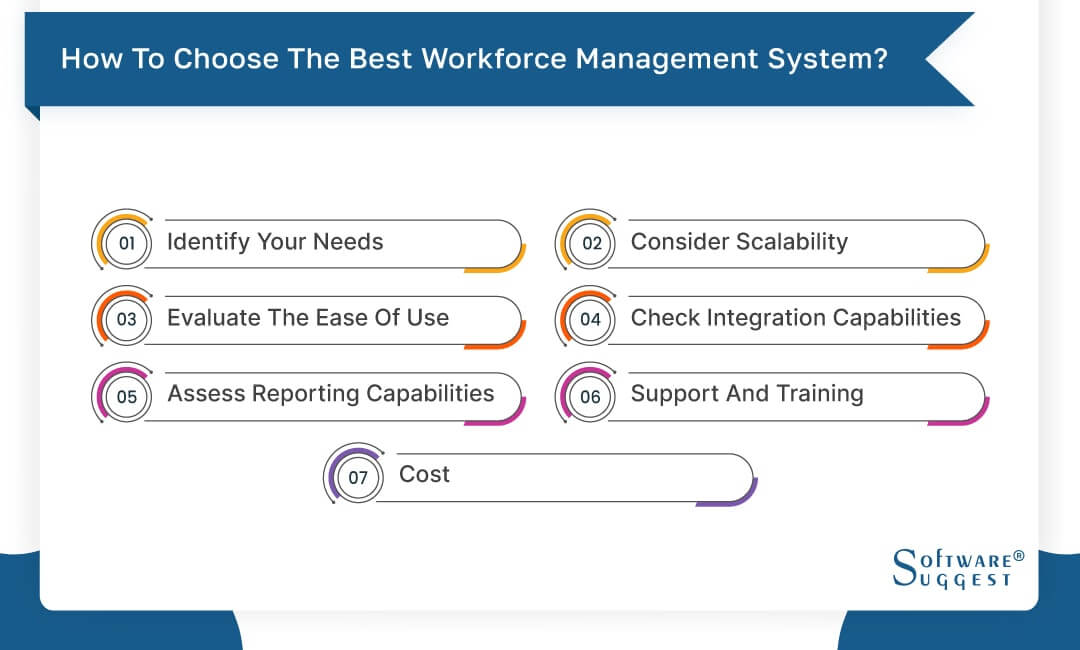
-
Identify Your Needs
Before selecting a workforce management system, assess your organization's needs and requirements. Consider factors such as the size of your workforce, industry-specific needs, and the functionalities you require to streamline your HR processes effectively. Identifying your needs will help you narrow down options that align with your requirements.
-
Consider Scalability
Choosing a top workforce management software that can scale alongside your organization's growth is essential. Consider whether the system can accommodate an increasing number of employees, additional locations, or new departments. Scalability ensures that the system can adapt to your changing needs without requiring a significant overhaul or replacement in the future.
-
Evaluate the Ease of Use
User-friendliness is a critical factor in selecting a workforce management system. This WFM software should have an intuitive interface and be easy to navigate for administrators and end-users. A system that is easy to use minimizes the learning curve for employees, reduces the chances of errors, and ensures efficient adoption and utilization across the organization.
-
Check Integration Capabilities
Consider the integration capabilities of the WFM software with other existing software and systems within your organization, such as the human resource information system or payroll software. Seamless integration enables data flow and synchronization between different systems, minimizing manual data entry and ensuring accurate and up-to-date information.
-
Assess Reporting Capabilities
Reporting capabilities play a vital role in extracting valuable insights from workforce data. Evaluate the reporting functionalities of the software and ensure that it provides comprehensive and customizable reports. The system should offer the ability to generate reports on key HR metrics, such as attendance, scheduling, labor costs, and performance, enabling data-driven decision-making and strategic planning.
-
Support and Training
Consider the support and training the workforce management system provider provides. Ensure that they offer sufficient customer support channels, such as phone or email, to address any technical issues or inquiries promptly. Additionally, assess the availability of training resources, such as user manuals, video tutorials, or on-site training sessions, to ensure a smooth implementation and user adoption.
-
Cost
Consider the cost of implementing and maintaining the WFM software. Evaluate whether the pricing structure aligns with your organization's budget and whether the system provides value for the investment. Consider any additional costs, such as licensing fees, customization, or ongoing support and maintenance, to make an informed financial decision.
Top 5 Workforce Management Software Comparison
|
Name
|
Free Trial
|
Demo
|
Pricing
|
|---|---|---|---|
| Yes |
Yes |
Starts at $49 | |
|
14 Days |
Yes | Starts at $29 | |
|
90 Days |
Yes |
On-Request | |
| 14 Days |
Yes |
Starts at $0 | |
|
Yes |
Yes |
Starts at $6 |
In the realm of efficient workforce management, there are several remarkable software solutions that empower businesses to streamline their operations and maximize productivity. Let us delve into the best workforce management tools available.
1. Deel
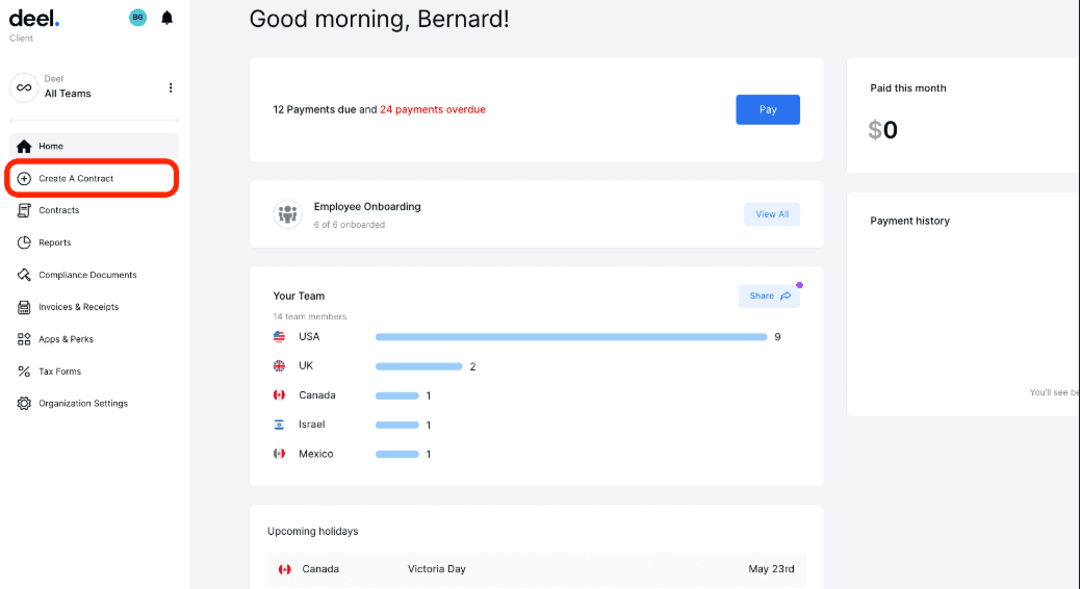
Deel is a global payroll and compliance platform that simplifies and streamlines the process of hiring and paying remote workers worldwide. It provides a comprehensive suite of tools and services to help businesses manage their international workforce efficiently.
With Deel, one of the top workforce management companies, you can easily onboard and manage contractors, freelancers, and full-time employees in different countries, all from a centralized platform. This WFM platform handles complex payroll calculations, tax compliance, and legal documentation, ensuring businesses comply with local regulations.
Features
- Compliance management
- Centralized onboarding
- Automated payroll system
- Compliance and documentation
- Contract templates
- Time tracking and expense management
- Analytical reporting
Pros
- The system has a good user interface and provides a great user experience
- Makes it easy to maintain compliance with international contracts
- The feature of automated invoices saves a lot of time
- Offers a simple, transparent, and quick method for receiving money from abroad
Cons
- Understanding of fees structure requires more time
- There are fewer withdrawal and deposit options on the platform
- Some occasional bugs disturb the flow while performing the task
Pricing
- Contractors: Starting from $49
- For Employees: Starting from $599
- Direct Employees: Start for free
2. Connecteam

Connecteam is the top workforce management software that helps manage the workforce and enables businesses to oversee their mobile and remote employees effectively. By harnessing robust functionalities and instinctive features, Connecteam provides an all-encompassing solution for optimizing communication, scheduling, task management, and training. The platform's user-centric interface and customizable toolkit facilitate seamless adaptation and tailoring of workflows to meet individualized requirements.
Features
- Task management
- Scheduling
- Forms and checklists
- Operation management
- Employee onboarding
- Compliance
- Employee engagement tools
- Instant messaging tool
- Real-time insights
Pros
- Connecteam provides an intuitive and easy-to-use interface
- The platform allows businesses to customize their workflows, forms, and checklists
- Offers various communication tools, including group chats, updates, and employee directories
- The platform provides time-tracking and scheduling features
Cons
- While Connecteam offers a free plan, its premium plans can be relatively expensive
- Although the platform is user-friendly, there may still be a learning curve for employees
- Connecteam's integrations with other third-party software and tools may be limited compared to other platforms
- Some users may find the reporting and analytics capabilities to be limited
- Some users have reported that the customer support provided by Connecteam can be slow or unresponsive at times
Pricing
- Expert: $99/month
- Advanced: $49/month
- Basic: $29/month
- Small business: $0
3. ADP

ADP (Automatic Data Processing) is a leading global comprehensive human capital management solution provider. With a strong presence in the market, ADP offers a range of services and software to help businesses effectively manage their workforce. Their offerings include payroll processing, time and attendance tracking, benefits administration, talent management, and more. ADP's solutions are designed to streamline HR processes, improve operational efficiency, and ensure compliance with regulations.
Features
- Payroll processing
- Time and attendance tracking
- Benefits administration
- Talent management
- HR compliance and reporting
- Employee self-service
- Analytics and Reporting
- Mobile access
- Integration capabilities
- Compliance support
Pros
- The platform automatically creates forms and critical paperwork for tax
- Give access to payment details to all employees
- Easy to manage access from an admin perspective
- The software is a scalable and flexible HCM solution
- Helped recruit and screen candidates with ADP screening and selection services
Cons
- UX is good, but it can be made better in comparison with other tools
- Customer service as a service offering is vast, so it becomes difficult to find the right expert
- Interface appearance and categorization could be more synchronized
- Encountered some glitches related to registration and accessing training in the ADP comprehensive learning system
Pricing
-
On request
4. Homebase

Homebase is a user-friendly and comprehensive workforce management platform designed to simplify workforce operations for small businesses. With a focus on the needs of local businesses, Homebase offers a range of features that streamline time tracking, scheduling, and team communication.
The platform allows businesses to create and manage employee schedules, track attendance, and handle shift swaps efficiently. It also provides tools for easy team messaging and collaboration.
Features
- Employee scheduling
- Time clock and attendance tracking
- Team communication
- Labor cost optimization
- Shift swapping and availability management
- Compliance and labor law support
- Onboarding and employee documents
- Reporting and analytics
- Mobile app and accessibility
Pros
- Homebase offers a user-friendly interface for creating and managing employee schedules
- The software provides time-tracking features, allowing employees to clock in and out using a mobile app or web browser
- Offers communication tools such as group messaging and announcements, enabling efficient communication between managers and employees
- With software, businesses can monitor labor costs and labor-to-sales ratios in real-time
- Homebase integrates with various payroll providers and POS systems
- Homebase offers a mobile app for both iOS and Android devices
Cons
- Some users find that Homebase's reporting and analytics capabilities are relatively basic
- Homebase has certain limitations when it comes to customizing features and workflows to match specific business needs
- While Homebase is generally user-friendly, new users may require some time to become familiar with the interface and features
- Some users have reported mixed experiences with Homebase's customer support
- The pricing structure can be a disadvantage for certain businesses, especially those with smaller budgets
Pricing
- Basic: $0 for 1 location up to 20 employees
- Essentials: $24.95/location/month, unlimited employees
- Plus: $59.95/location/month, unlimited employees
- All-in-one: $99.95/location/month, unlimited employees
5. SyncHR

SyncHR is one of the best workforce management companies that offers a modern and streamlined approach to managing HR processes. With a focus on automation and efficiency, SyncHR provides businesses with advanced features for HR administration, payroll, benefits management, talent management, and analytics.
The platform's innovative technology and intuitive interface empower organizations to streamline their HR operations, improve data accuracy, and enhance employee experiences.
Features
- HR administration
- Payroll management
- Benefits administration
- Time and attendance tracking
- Performance management
- Talent management
- Analytics and reporting
- Compliance management
- Employee self-service
- Integration capabilities
Pros
- SyncHR integrates HR and payroll functions into a single platform, providing a comprehensive solution for managing employee data, benefits, time and attendance, payroll processing, and more
- Offers robust automation capabilities, allowing businesses to automate HR workflows
- Automation reduces administrative tasks and enhances efficiency
- SyncHR is known for its configuration, enabling businesses to adapt the software to their specific HR processes and policies
- It keeps up with changing HR regulations and compliance requirements, helping businesses stay compliant with labor laws and avoid penalties
- SyncHR provides self-service features, allowing employees to access and manage their personal information, benefits, pay stubs, and time-off requests
Cons
- Implementing and configuring SyncHR can be complex, requiring careful setup and customization to align with business requirements
- SyncHR's pricing structure may concern small businesses or those with limited budgets
- Some users have reported mixed experiences with SyncHR's customer support
- SyncHR's integration options with other third-party software and tools may be limited compared to other HR and payroll platforms
Pricing
- Teams Standard: $6 per user per month, billed annually
- Teams Unlimited:$15 per user per month, billed annually; $ 18 per user, billed monthly
- Enterprise: On request
Challenges in Workforce Management Tools
Implementing and managing a workforce management software system comes with its set of challenges. It's important to be aware of these challenges to effectively address them and ensure a smooth operation of the software within the organization. Let's explore some common challenges in HR workforce management software.
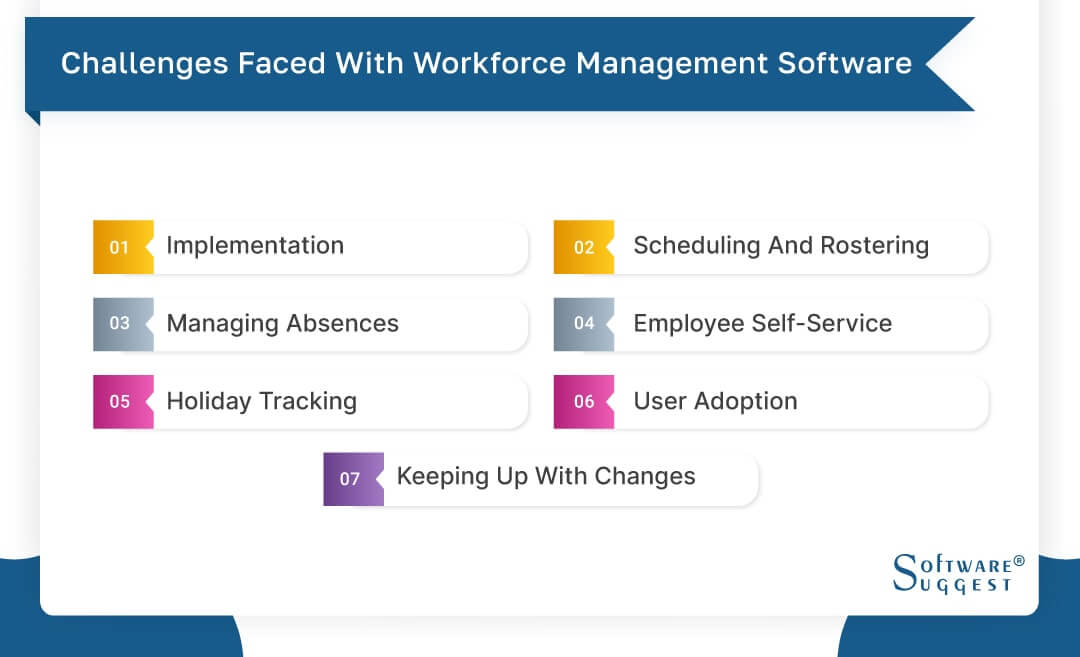
-
Implementation
Implementing a workforce management software system can be a complex process. Challenges may arise during the initial setup, including data migration, configuration, and integration with existing systems. Ensuring a seamless implementation requires careful planning, effective project management, and close collaboration with the software provider.
-
Scheduling and Rostering
Creating efficient and accurate schedules and rosters can be challenging, especially in organizations with dynamic and fluctuating staffing needs. Balancing employee availability, skills, and preferences while considering workload demands and labor laws can be complex. WFM software provides tools to automate scheduling processes, but challenges may arise in optimizing schedules for maximum productivity and employee satisfaction.
-
Managing Absences
Managing employee absences, such as vacations, sick leaves, or personal days, can be challenging without proper systems in place. Workforce management software helps in tracking and managing absences; however, challenges may arise in handling unplanned absences, last-minute changes, and ensuring adequate coverage. Efficient absence management is crucial to maintain operational continuity and prevent understaffing issues.
-
Employee Self-Service
Workforce management software vendors include employee self-service capabilities, allowing employees to access and manage their information. However, challenges may arise in encouraging employee adoption and ensuring accurate data entry. Providing adequate training and support, as well as promoting the benefits of self-service, can help overcome these challenges and promote employee engagement.
-
Holiday Tracking
Tracking and managing employee holiday entitlements and requests can be complex, especially in organizations with varying holiday policies and multiple employee groups. WFM tools can help streamline holiday tracking, but challenges may arise in accurately calculating entitlements, managing conflicts, and ensuring fair allocation of holiday time.
-
User Adoption
Ensuring user adoption and engagement with workforce management software can be a challenge. Some employees may resist change or be reluctant to embrace new technologies. Overcoming this challenge requires effective communication, training programs, and demonstrating the benefits of the software to employees at all levels. User-friendly interfaces and ongoing support can also promote successful adoption.
-
Keeping Up with Changes
Workforce management software companies need to adapt to evolving business needs, industry regulations, and technological advancements. Challenges may arise in keeping the software up-to-date with changes in labor laws, organizational policies, or industry requirements. Regular software updates, continuous training, and proactive monitoring of changes can help overcome these challenges and ensure compliance.
Trends in Workforce Management Software
The field of workforce management software is constantly evolving to meet the changing needs of organizations and advancements in technology. Several trends have emerged in recent years that are shaping the landscape of WFM software.
Let's explore some of these trends.
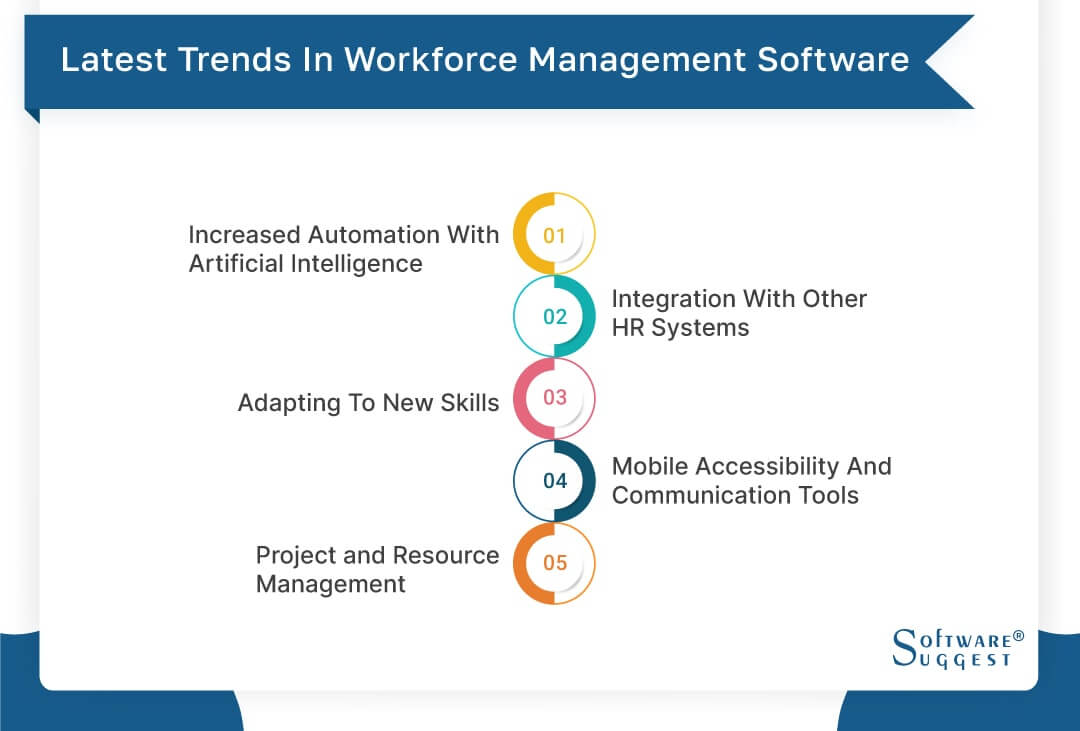
-
Increased Automation with Artificial Intelligence
Artificial Intelligence (AI) is revolutionizing workforce management software by enabling increased automation and intelligent decision-making. AI-powered algorithms can automate tasks such as scheduling, forecasting, and data analysis, saving time and reducing human error. AI also enables predictive analytics, helping organizations make informed decisions regarding workforce planning, talent management, and resource allocation.
-
Integration with Other HR Systems
Workforce management software is increasingly being integrated with other HR systems, such as human resource information systems (HRIS), payroll software, and talent management platforms. This integration allows for seamless data flow and synchronization between different HR functions, eliminating the need for manual data entry and ensuring accurate and up-to-date information across systems.
-
Adapting to New Skills
As the job market evolves, organizations are focusing on developing and managing new skills within their workforce. Workforce management software is adapting to this trend by offering features such as skills management, learning management, and talent development functionalities. These tools help organizations identify skill gaps, plan training programs, and track the progress and effectiveness of skill development initiatives.
-
Mobile Accessibility and Communication Tools
With the increasing prevalence of remote work and mobile devices, workforce management software is incorporating mobile accessibility and communication tools. Mobile apps allow employees to access their schedules, submit time-off requests, and communicate with managers and colleagues on the go. These tools enhance flexibility, collaboration, and real-time communication, leading to improved efficiency and employee engagement.
-
Project and Resource Management
Workforce management software is expanding beyond traditional scheduling and time management functionalities to include project and resource management features. These tools enable organizations to effectively allocate resources, track project progress, and manage workloads. They provide visibility into resource availability, facilitate collaboration among team members, and ensure optimal utilization of resources.
Conclusion
In conclusion, workforce management software has become an indispensable tool for organizations seeking to optimize their HR processes, streamline operations, and effectively manage their workforce. The software offers a wide range of features and functionalities that automate and simplify tasks related to scheduling, time and attendance management, performance tracking, and more.
By implementing WFM software, organizations can enjoy numerous benefits, including improved accuracy, enhanced productivity, better compliance with labor regulations, enhanced communication, increased employee satisfaction, time savings, and better resource allocation. These benefits contribute to overall operational efficiency and enable organizations to make data-driven decisions for strategic workforce planning.
FAQs
Workforce management (WFM) software is meant to maximize the performance levels and competency of an organization. Workforce planning software can help you collect real-time data, manage field workers and your employees.
The cost of workforce management software can vary depending on several factors, including the size of the organization, the specific features and functionalities required, and the software provider. Workforce management software is typically offered through subscription-based pricing models, which may be based on the number of employees or users or the level of functionality required.
For small and medium-sized businesses, the cost of workforce management software can range from a few hundred dollars per month to a few thousand dollars per year. This cost usually includes access to the software platform, regular updates and support, and basic features such as scheduling, time and attendance tracking, and reporting.
For larger enterprises with more complex workforce management needs, the cost can be higher due to the scale of the organization and the additional features and customization options required. The pricing for enterprise-level workforce management software can range from several thousand dollars per year to tens of thousands of dollars or more, depending on the specific requirements and the number of employees.
Small and midsize businesses (SMBs) can effectively utilize workforce management software to streamline their HR processes and maximize their workforce's productivity. Firstly, SMBs can leverage the scheduling and shift management features of workforce management software to optimize their workforce allocation.
By creating and managing employee schedules efficiently, SMBs can ensure appropriate staffing levels, reduce scheduling conflicts, and improve operational efficiency. The software enables them to assign shifts, track employee availability, handle time-off requests, and facilitate shift swaps, all in a centralized platform. This level of automation and organization helps SMBs effectively manage their workforce and ensure smooth operations.
Yes, workforce management tools can often be customized to meet an organization's specific needs. While many software solutions come with a range of standard features and functionalities, they also offer options for customization and configuration. This allows organizations to tailor the software to align with their unique requirements, workflows, and business processes.
The customization options in workforce management software can vary depending on the provider and the specific software solution. Some common customization features include configurable workflows, data fields and reporting, role-based permissions, integration with existing systems, and user interface customization. So, get workforce management software that aligns with your requirements.
The implementation timeline for workforce management software can vary depending on several factors, including the size of the organization, the complexity of the software solution, the level of customization required, and the readiness of the organization in terms of data preparation and user training. On average, the implementation process can take anywhere from a few weeks to several months.
For small to midsize businesses with straightforward requirements and minimal customization needs, the implementation process can typically be completed within a few weeks. This includes activities such as initial system setup, data migration, configuration of basic features, and user training. The timeline may also depend on the availability of resources and the level of support provided by the software provider or implementation team.
For larger organizations with complex requirements and a need for extensive customization, the implementation process may span several months. This allows for in-depth configuration of features, integration with other systems, and comprehensive user training. The timeline may also involve multiple stages or phases of implementation to ensure a smooth transition and minimize disruption to ongoing operations.
By Countries
By Industries








.jpg)















.png)